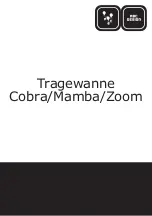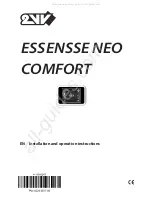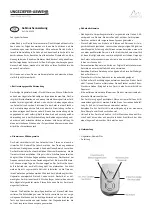
MX31 Cab, MX31FU Radio Cab Page 27
Re-charging recommendation.
Recharging the battery after a short operating time (when the battery remains in a reasonably charged state) should
be avoided, because it could shorten the live of the battery.
Noteworthy characteristics when operating in radio mode:
Whether or not a radio communication is established is indicated to the user, similar as with the teth-
ered cab, by the
communications dot
in the display (OPERATOR mode: left lower corner)
.
When ac-
tuating the cab (address activation, speed changes, directional change, function, etc.), the
commu-
nications dot
lights up and remains lit until an acknowledgment is received from the radio base
module. If the communications dot remains lit for an extended period of time, it indicates that the
communication is interrupted (e.g. distance too far or other sources of interference).
“COMM FAILED”
is displayed if the communication is down completely.
■
If several radio cabs are in operation, they should not be in close proximity to each other; a mini-
mum distance of 1m (3 feet) between two cabs is recommended.
The Antenna (enclosed with the MXFU and MX31FU):
The radio base module MXFU should never be operated without the antenna. Screw the antenna to
the terminal through the opening in the cover. The radio cab may be used without the antenna for
short distances (@ 20m (60 ft.) and only few obstacles). Otherwise please mount the antenna!
Actions to take in case of radio communication interference:
There are 8 frequencies (channels) to choose from, selectable with jumpers next to the CAN bus
sockets, in order to eliminate interferences coming from other radio equipment. After a frequency
change is made, connect the radio cabs briefly to the CAN bus to initiate communications. See
above.
The three jumpers marked “1”, “2” and “4” allow for 8 combinations and therefore 8 different channels
to choose from. All jumpers bridged as delivered, results in channel “0”.
The signature number mentioned at the beginning of this chapter can be changed in the MXFU by
means of a CV, in case two systems with the same number are operated close by (rather unlikely).
18. Glossary
8/12
E-procedure to select between 8 and 12 functions
ABK
E-procedure to set characteristic curves for AZ and BZ.
ACK
Successful programming step acknowledged
AOS
Automatic Operating Sequences
ARS
Automatic Route Sequences
AZ
E-procedure to set acceleration rate with cab (not CV)
BAB
E-procedure for switch ladders, automatic operating sequences (AOS),
automatic routing sequences (ARS) etc.
BI-ACK
Successful “bidirectional” programming acknowledged
BI-READ
Successful “bidirectional” read-out
BIN
Displays CV value as Binary code
BZ
E-procedure to set deceleration rate with cab (not CV)
CAN
Controller Area Network = ZIMO bus
DAK
On the “A” button, stands for “Deactivate”
DCAB
Dual Cab mode, controls two engines simultaneously
FU e/a
“
A” key also functions to turn radio cab on/off when in radio mode
H
Indicates
Halt (stop) signal on track (light bar)
ICO
Displays icons
L
Indicates
(light bar) when speed limit signal is applied
M/D
E-procedure to set function keys to either momentary or permanent “on”
MN
Manual key: overrides stop, speed limits and momentum
NO-READ
No value received from a “bidirectional” decoder
NAM
E-procedure to add names
P
Selects a DCC protocol
PICT
Switches to pictorial
PRA
Personal Railroad Assistant = PDA software
PUK
Sends function commands as pulse chain commands (older LGB only)
READ
CV read-out successful
RG
Shunting key: half speed and/or shunting functions
RÜB
E-procedure to set recall memory depth
RM
Recall Memory depth indicator
RM-L
Recall Memory for loco mode
RM-SW
Recall Memory for switch mode
s
Indicates speed step
applied
SSP
Emergency stop of all locos
STP
CTC-Computer software by E.Sperrer
STU
Button markings for quick speed step mode selection/confirmation
T P
Button for building or taking apart consists
U
Button for “hand-offs”
UEP
Short circuit on programming track output
UES
Short circuit on main track output
v
Actual speed reported back by decoder
XDACB
Exit dual cab mode
ZST
Program for updating ZIMO hardware



































